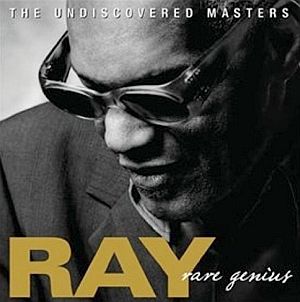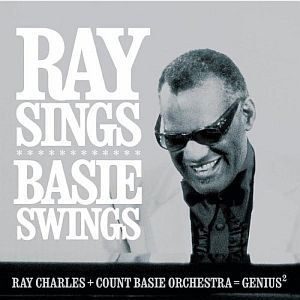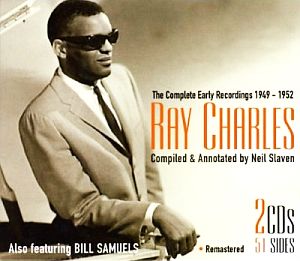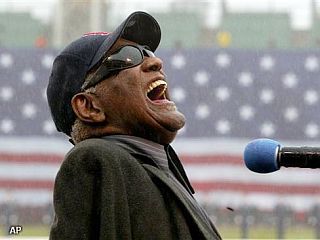
Ray Charles performing “America the Beautiful” at Fenway Park prior to a Boston Red Sox baseball game, April 2003. AP photo.
Also an accomplished jazz, gospel, and country-and-western virtuoso, Ray Charles shone through movingly whenever he performed “America The Beautiful” — as he did in many of his performances generally. But with this song in particular his spirited interpretation often moved listeners to tears and/or deep patriotic feeling.
Charles’ version of the song, or part of it, was featured in a 2011 General Motors TV advertisement that ran during the 2011 World Series. It was used as the soundtrack for a Chevrolet ad touting the car company’s 100th anniversary.
The 60-second ad, offered below, shows a sequence of hand-held family-album photos of older Chevrolet car and truck models juxtaposed against more recent American scenes and iconic moments.
With Charles providing the requisite “American” music in the ad, Chevy was trying to imbue itself and its models with a sense of American history — and viewers of the ad with a patriotic feeling. And with Ray’s help, they may well have succeeded. Chevrolet has a long history of trying to associate its name and products with American patriotism, and with Ray Charles singing “America the Beautiful” in this ad, they were certainly hitting some persuasive notes. But the story that follows here is more about Ray’s history with this particular song than Chevrolet cars and trucks.
The Ray Charles version of “America the Beautiful” is a much-loved song by many Americans, and is generally regarded as something of a classic. His version of the song dates to the early 1970s when he and friend Quincy Jones, the music producer, first recorded it. Since then, and over the last 40 years, Charles’ version of “America The Beautiful” has had periods of notable popularity and political use. During his career, Charles performed the song numerous times, and in later years, often in prime-time televised venues such as presidential conventions, 4th-of-July gatherings, the Super Bowl, World Series, and other major events. More on the history of these performances and the Ray Charles song in a moment. First, a brief look at “America the Beautiful’s” origin and creation.
1890s
“Purple Mountains…”

Professor Katharine Bates was inspired by America’s beauty.
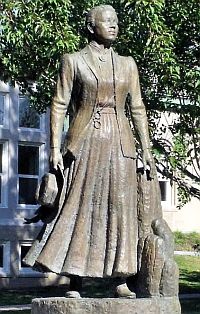
Statue of Katherine Lee Bates on grounds of Falmouth, MA library.
However, another American song, “The Star-Spangled Banner,” would become the national anthem. That song had been written in 1814 by Francis Scott Key after Key had witnessed the British bombardment of Fort McHenry during the War of 1812. By 1889, the song was in official use by the U.S. Navy, and by 1916, also by the President. It was made the national anthem by a congressional resolution in March 1931.
However, over the years, some have argued that “America the Beautiful” would serve as a better national anthem, and periodically the song has been proposed to replace “The Star-Spangled Banner” as National Anthem. And for some, the Ray Charles version of “America the Beautiful” makes a persuasive case for making that song the National Anthem.
1972
Ray’s Version
Ray Charles had become a popular rhythm and blues artist by the 1960s, with a number of hit songs topping the music charts of that day. In 1972 Charles was with the ABC recording company, and had set out to record an album of songs about America and its people, which later became, A Message From The People. It included ten songs, among them, “Lift Every Voice and Sing,” “Abraham, Martin and John,” and “America The Beautiful,” all produced by Quincy Jones.On that album, Charles sang “America the Beautiful” in a slow, rocking tempo, removing and/or reordering some verses, and emphasizing sections of the song that focus on the bravery of American heroes. “Then I put a little country church backbeat on it and turned it my way,” said Charles of the song in one interview. On the 1972 album cover, shown at right, the cover art includes sketches of martyred American leaders – Robert F. Kennedy, Abraham Lincoln, Martin Luther King, and John F. Kennedy — seen in light background.

“America the Beautiful” single, “arranged & adapted” by Ray Charles.
1980s
Republican Convention
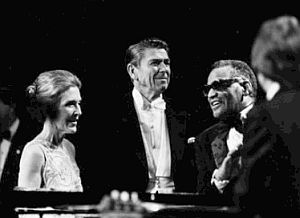
1981 Inauguration. First Lady Nancy Reagan and President Ronald Reagan with Ray Charles after his performance.

President and Nancy Reagan with Ray Charles after President Reagan’s acceptance speech at the Republican National Convention, Dallas, Texas. August 23, 1984.
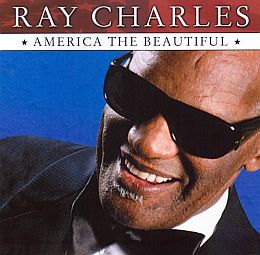
Ray Charles shown on CD cover for 2005 album featuring “America the Beautiful” and other songs for Madacy Records. Click for CD.
Regardless of politics, the Ray Charles version of “America the Beautiful” has grown on people over the years, with many finding it especially moving. On the web, for example, one blogger writes: “Hearing his rendition of ‘America The Beautiful’ never fails to move me to tears.” That kind of comment is not unusual. In fact, some regard the Charles version as the singular version, and in class all its own.
Ed Bradley, the late 60 Minutes correspondent, called it “the definitive version…an American anthem – a classic, just as the man who sang it.” Others have suggested that Congress should “retire” the song in Charles’ honor. Another writes that Charles’ performance of the song “is an awesome, noteworthy, modern, musical achievement” for which Charles should be “forever honored.”
Still others have gone somewhat deeper into how Charles sings the song – namely how he would often lead his performance with the less-well known third verse:
O beautiful for heroes proved
in liberating strife
Who more than self their country loved
And mercy more than life
America, America
May God thy gold refine
Till all success be nobleness
And every gain divine
According to some accounts, the poem’s original author, Katherine Bates, was making some pointed critique in this verse of the materialistic and self-serving robber barons of the 1890s, and was urging America to live up to its more nobler self and ideals. She was also honoring the memory of those who died for their country. Charles too, in his selection of the third verse as lead, is making this emphasis as well and more, as Newark Star-Ledger columnist Charles Taylor explains in a 2004 article for Salon.com:
“…Think about what that reordering does, what it means to hear those words before the familiar ‘O beautiful, for spacious skies…’ Beginning with images of sacrifice and death, then moving on to a prayer that asks — with no guarantee of being answered — that those sacrifices not be in vain, Ray Charles implies that America must earn the verse that follows.”
In his performances, Charles would often get to the first verse of the poem somewhat later, explaining to his audience as he went: “…And you know when I was in school we used to sing it something like this…,” then singing the familiar verse.Ray Charles’ version of the song “teaches… a new humility.”
– C. Taylor, Salon.com. Charles Taylor, in Salon.com, continues making his point:
“…So the purple mountains’ majesty above the fruited plains are introduced as a legend we hear as children. They are not, in this [Ray Charles] version, God’s bounty there for our taking, but the reward of a collective dream, a dream all the sweeter, all the more worth working toward because it will never fully be realized. God may or may not reward that striving, but as Charles sings it, the striving is where the concrete beauty of the country lies.”
“‘America the Beautiful’ is the least boastful of patriotic songs, and even so, Ray Charles’ version teaches it a new humility. ….”
After 9/11
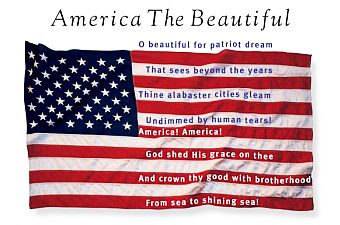
“America The Beautiful” poster showing the fourth and final verse of the song.
“On September 13, 2001, the radio station I listened to went back to playing music after nearly two days of news reports. This was the first song I heard that morning after getting into my car, and it almost moved me to tears. Charles begins with what is traditionally the third verse: ‘Oh beautiful for heroes proved in liberating strife, who more than self their country loved, and mercy more than life.’ Given the events of two days earlier, it was incredibly powerful and almost eerily poignant. I have only rarely heard this song — it is not the type of song that is typically played on the radio — but I feel that Charles’ rendition is the definitive version of the song, and it provided for me a musical memory I will never forget.”
Also in the aftermath of the 9/11 attacks, on October 28th, at the opening of Game 2 of the delayed 2001 World Series (New York Yankees vs. Arizona Diamondbacks), Ray performed a moving version of “America the Beautiful” at the Diamondbacks’ ballpark in Phoenix, shown below, beginning with his favored third verse.
“Music really and truly is my bloodstream you know — my breathing, my respi- ratory system. And as long as the public is willing to listen to me, there ain’t no retiring until the day when they put me away.”
-Ray Charles
In September 2002, Charles produced another “American songs” album — Ray Charles Sings For America, by Rhino records (shown earlier above). This compilation, coming a year after the terrorist attacks, was a collection of American tribute songs with a few new tracks from Charles, including a spoken version, “Ray Reflects On America” and “God Bless America Again.” The collection also includes “America The Beautiful.” The following spring, on Friday, April 11, 2003, Charles sang “America The Beautiful” at Fenway Park in Boston at the Red Sox opening day baseball game against the Baltimore Orioles (photo at top of this story).
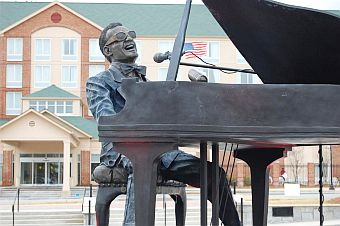
In Ray Charles’ birthplace of Albany, Georgia, a revolving, illuminated, bronze statue of Charles seated at a baby grand piano (by sculptor Andy Davis) is the centerpiece of the Ray Charles plaza and park.
Ray Charles, at age 73, passed on in 2004. However, he leaves behind a giant musical legacy for the ages, of which “America the Beautiful” is just one part — though an important and enduring interpretation that will continue to move people for many years to come.
Also at this website,Ray’s version of the Beatles song, “Eleanor Rigby,” is included as a full audio file in that story. See also the “Annals of Music” page for additional stories in that category. Thanks for visiting – and if you like what you find here, please make a donation to help support the research and writing at this website. Thank you. – Jack Doyle.
|
Please Support Thank You |
____________________________________
Date Posted: 5 November 2011
Last Update: 3 July 2020
Comments to: jdoyle@pophistorydig.com
Article Citation:
Jack Doyle, “Ray Sings America, 1972-2011,”
PopHistoryDig.com, November 5, 2011.
____________________________________
Sources, Links & Additional Information
Stuart Elliott, “Chevy Turns to Pictures to Celebrate a Centennial,” New York Times, October 19, 2011.
Ray Charles, “America The Beautiful,” in performance, Dick Cavett Show, Sept. 18, 1972.
“Ray Charles Albums,” RayCharles.com.
“Ray Charles,”Wikipedia.org.
“America The Beautiful by Ray Charles,” SongFacts.com.
“Ray Charles Bio,” SwingMusic .net.
“Ray Charles Sings ‘America the Beautiful’ to Close GOP Convention,” NBC Nightly News, August 24, 1984.
Tom Shales, “Battle Hymn Of the Republicans,” Washington Post, August 24, 1984, p. B-1.
Philip H. Dougherty, “Advertising; Campaign Set to Aid Disabled,” New York Times, April 19, 1985
Ray Charles, “America The Beautiful,” in performance, McCallum Theater, 1991.
Jon Pareles and Bernard Weinraub, “Ray Charles, Bluesy Essence of Soul, Is Dead at 73,” New York Times, June 11, 2004.
Charles Taylor, “The Genius Hits the Road,” Salon.com, Friday, June 11, 2004.
Bob Herbert, “Loving Ray Charles,” New York Times, June 14, 2004.
“An Appreciation of Ray Charles,” The Charlie Rose Show, Interviews with Phil Ramone, Marcus Roberts, Anthony Decurtis, June 14, 2004.
“Ray Charles At Republican Party Convention in 1984,” Ray Charles Video Museum, May 30 2010.
CBS Evening News, “The Deaths of Ronald Reagan and Ray Charles – June 2004 (4:45),” YouTube.
Rebecca Leung, “The Genius Of Ray Charles,” CBSNews.com, February 18, 2009.
“Ray Charles,” in Holly George-Warren and Patricia Romanowski (eds), The Rolling Stone Encyclopedia of Rock & Roll, Rolling Stone Press, New York, 3rd Edition, 2001, pp. 165-167.
____________________________


